
As companies reset their corporate travel strategies for the remainder of 2025—and look ahead to 2026—sentiment is improving and structural shifts in how business travelers plan may create new opportunities for chauffeured transportation operators who target premium service. According to the Global Business Travel Association’s (GBTA) 37th Business Travel Industry Outlook, 43% of business travel professionals now say they are more optimistic, up 15 points in recent months. Yet, concerns remain around lower trip counts and lower spend forecasts—meaning each trip must work harder and each leg within trips must be more productive.
“This latest poll reflects what has always been the industry’s innate ability to innovate and change—to succeed in the face of challenges. Business travel is showing signs of resilience and adaptation, with optimism rebounding and new patterns emerging,” says GBTA CEO Suzanne Neufang.
 GBTA CEO Suzanne Neufang
GBTA CEO Suzanne Neufang
Longer itineraries, multi-stop patterns, and fewer same-day out-and-back runs are becoming the new norm. Nearly two in five buyers are seeing more “linked” multi-city trips, with a third reporting longer durations. These dynamics favor pre-arranged, reliable second- and third-city transfers—which is where our industry shines in comparison to other types of transportation. Premium economy growth also signals continued traveler willingness to pay for comfort, and GBTA reports that many employees are already voluntarily self-funding upgrades such as lounges, cabin classes, and extra hotel nights, which is also a good sign for our industry.
It should come as no surprise that blended travel continues to expand—with 43% of respondents reporting that they have defined bleisure policies—and companies cite employee satisfaction and work-life balance improvement as ROI. Accessibility, however, remains a structural gap: Only 18% of managers say their company meaningfully accommodates accessibility needs, despite high traveler demand. Chauffeured providers with ADA-forward fleets and booking clarity may have an immediate differentiator.
Of course, the elephant in the room is still technology. Half of suppliers and TMCs and one-third of buyers are already experimenting with autonomous AI for personalization, itinerary automation, and expense. Data privacy and security along with integration with existing systems are top concerns for buyers, suppliers, and TMCs. Chauffeured operators who integrate seamlessly will have a fighting chance at capturing more of this business instead of the alternative.
Overall, business travelers are more optimistic, but also more selective. For chauffeured operators, this is a window to position as the high-assurance, low-friction connector between the airport, the hotel, and the meeting—exactly where business travelers are now spending more of their time.
One caveat: This report was released prior to the government shutdown in the US, which impacted flights and other modes of travel, especially starting in late October. While the shutdown has come to an end in Congress as of November 10, lingering fallout from the TAA’s reduction of flights plagues travelers. Here’s to hoping that conditions have improved and travelers are back to their expected schedules and destinations.
The full poll is available here.
Visit gbta.org for more information.
[11.11.25]




